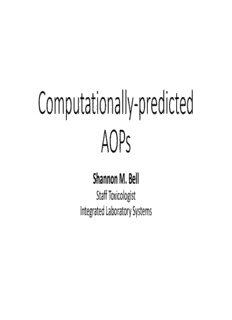
Computationally-predicted AOPs PDF
Preview Computationally-predicted AOPs
Computationally-predicted AOPs Shannon M. Bell Staff Toxicologist Integrated Laboratory Systems How do we go from a mouse, a chip/plate, or a poke to a population... Quickly, easily, cheaply, and transparently? l a u d i v i d n I e u s s i T r a l u c e l o M 3 Overview of the AOP framework Omics/HTT Phenotyping Biomonitoring Molecular Cellular Tissue Organ Individual Population Molecular initiating event Key events (KE) (MIE) Adverse Outcome (AO) Intermediate effects or Chemical induced This may occur at the predictive associations perturbations that affect population level for spanning several levels of biological systems at the ecological outcomes or at biological association molecular level. the individual level for KE are measurable One MIE may lead to human health outcomes multiple AO 4 Adapted from Noffisat Oki AOa KE1 KE2 KE3 KE4 KE5 AOb AOa KE1 KE2 KE3 KE4 KE5 AOc KE1 KE2 KE3 KE4 KE5 AOb KE1 KE2 KE3 KE4 KE5 AOc KE1 KE2 KE3 KE4 KE5 AOa 5 AOP Discovery & Development computationally- predicted AOPs & Putative AOPs <100s a year networks AOP Networks ~10s a year Formal AOPs <10s a year Quantitative AOPs Adapted from Steve Edwards DE gene Phenotype Other data expression data data Processing Discretized Enriched data pathways Data-generated connections Annotated HTS data associations Inferred connections Phenotype node cpAOP network Chemical Expression Adverse node outcome High through put screening 7 Bell et al, in submission Adverse Outcomes Metabolic Extracellular dysregulation Lipid and metabolic Phenotypes matrix dysregulation (phenotype) Protein metabolism Chemicals Cytotoxicity inflammation Pathways Cell cycle DNA Stress metabolism response HTS Endpoints Cell signaling Hedgehog Cell division/ Cancer /wnt proliferation MIE SREBP/ Fatty ERBB2/4/ ChREBP Lipid Liver AKT activation imbalance Bell et al, in submission Direct support in cpAOP subset Possible support in cpAOP subset 9 Weber, Boll and Stampfl 2003; Figure 3 Metabolic dysregulation Extracellular matrix Lipid and metabolic dysregulation (phenotype) Protein metabolism Cytotoxicity inflammation Cell cycle DNA metabolism Stress response Cell signaling
Description: